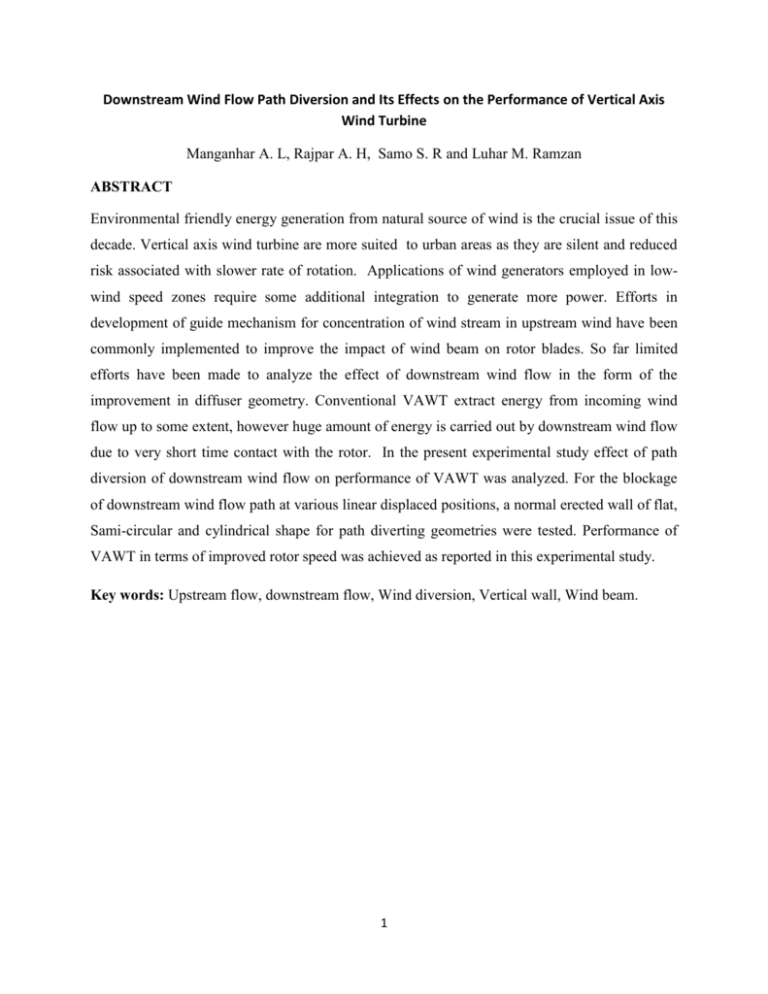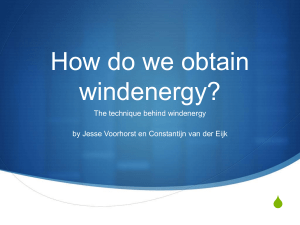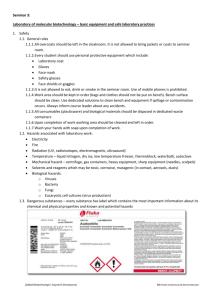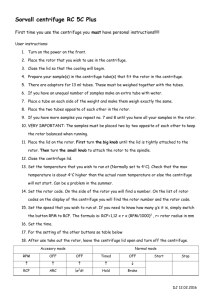Downstream Wind Flow Path Diversion and Its Effects on the
advertisement

Downstream Wind Flow Path Diversion and Its Effects on the Performance of Vertical Axis Wind Turbine Manganhar A. L, Rajpar A. H, Samo S. R and Luhar M. Ramzan ABSTRACT Environmental friendly energy generation from natural source of wind is the crucial issue of this decade. Vertical axis wind turbine are more suited to urban areas as they are silent and reduced risk associated with slower rate of rotation. Applications of wind generators employed in lowwind speed zones require some additional integration to generate more power. Efforts in development of guide mechanism for concentration of wind stream in upstream wind have been commonly implemented to improve the impact of wind beam on rotor blades. So far limited efforts have been made to analyze the effect of downstream wind flow in the form of the improvement in diffuser geometry. Conventional VAWT extract energy from incoming wind flow up to some extent, however huge amount of energy is carried out by downstream wind flow due to very short time contact with the rotor. In the present experimental study effect of path diversion of downstream wind flow on performance of VAWT was analyzed. For the blockage of downstream wind flow path at various linear displaced positions, a normal erected wall of flat, Sami-circular and cylindrical shape for path diverting geometries were tested. Performance of VAWT in terms of improved rotor speed was achieved as reported in this experimental study. Key words: Upstream flow, downstream flow, Wind diversion, Vertical wall, Wind beam. 1 design 1. INTRODUCTION suitable for low wind areas to improve the Urbanization and Industrialization are two important processes of incoming wind speed was proposed by socio-economic Govardhan and Dhanasekaran [4]. Vane development and are directly dependent of guided mechanism for upstream wind flow available energy. Fossil fuels will remain no for conventional wind turbine to study its more dependable to bear the load of effects on turbine performance has been continuous population growth and their development Environment processes has reported in [5] [6]. They have shown that requirements. gotten the efficiency and starting characteristics of continuously the Wells turbine (a ducted turbine) has been polluted through its quality degradation improved processes and will provide limited safe energy wind flow. It was proved that conventional wind capacity and potential to face future energy and the duct to guide and concentrate incoming wind and solar are dependable and have the Efficient with wind turbine with vertical bucket shaped generation processes. Renewable energy sources like challenges. compared Hu and Cheng [7] integrated a vertical axis is impossible without environmental friendly dependable when respective turbines without guided vanes. living to its users. Surely sustainable living and of ducted or funneled wind turbines turbine with integrated accelerating techniques has economic flow renewable resource based power generation around estimated is top priority of researchers. They have the that the wind improved the generator power and was extraction efficiency can be increased up to 80 % due been continuously working for improvement to ducting effect. in existing systems as well as searching for Abe etal[8], conducted experimental and innovation. analytical investigations on a new diffuser- In low windy or turbulent wind zones, shrouded wind turbine assembly. The Energy generation from wind by using characteristic values of the flow fields were conventional wind turbines would not be estimated and compared with those for a suitable for sustainable socio-economic bare wind turbine. It was concluded that the development to be diffuser-shrouded wind turbine provides integrated with wind concentrating and much higher power output as compared to guide techniques[1] [2] [3]. Modification in the bare wind turbine. The power coefficient but it is needed 2 of the diffuser-shrouded wind turbine design overcomes the inferior aspect of low claimed was about four times that of the wind speed by guiding and increasing the bare wind turbines. It is also reported that speed of high altitude wind through the with a simple momentum theory, developed ODGV. The expected wind speeds and, along the lines of momentum theory for bare therewith, the wind energy potential depends wind turbines, the power augmentation is strongly on the local weather conditions and proportional to the mass flow rate generated building arrangement. Modeling the flow at the nozzle of the diffuser augmented wind field in such urban canyons is difficult [15] turbine (DAWT) [9]. Such mass flow [16]. augmentation can be achieved through two A basic principles i.e. renewable energy and rain water harvester (i) Increase in the novel shrouded hybrid diffuser exit to inlet area ratio (ii) by with decreasing the negative back pressure at the (ODGV) for urban high-rise application was exit. introduced by W. T. Chong etal[17]. The Generally, urban areas have weak wind ODGV surrounds the vertical axis wind conditions and turbulence due to the turbine (VAWT) and enhances the VAWT presence of high rise buildings. The number performance by increasing the incoming of obstacles in the path of the wind also wind speed and guiding it to an optimum makes it difficult to model the wind resource flow angle before it interacts with the rotor [10] [11] [12]. Thus, the wind energy blades. The experimental results show that generation systems for urban regions need to the rotational speed of the VAWT increases overcome by about 2 times. these disadvantages. More an wind-solar Omni-directional-guide-vane effective systems are required to facilitate From this reviewed study it was observed these thickly populated low windy regions. that the performance of wind generator Grant et al[13], have also reported that working in low windy areas have been ducted wind turbine which is attached to the improved by concentrating and introducing roof of a building has the significant guide mechanism for upstream wind flow. potential for retrofitting onto the existing So for efforts have not been taken into building with minimum visual impact. consideration Omni-directional-guide-vane was introduced mechanism for downstream wind flow. The [14]. It was proposed that the patented present study is an attempt to extract 3 to introduce a guide maximum energy from the downstream 3. TEST SETUP wind flow by introducing a mechanism to In this experimental study a continuous, divert the downstream wind flow that may controlled source of wind was introduced so be more beneficial as compared to the that (i) minimize the error in analysis (ii) conventional outgoing wind flow. constant source of wind during experimentation. For continuous, constant 2. speed of the wind, a wind tunnel was used as SYSTEM DEVELOPMENT of 1m2 wind source. Average of five tests for each projected area with blade size of 0.92 x 0.46 setup was considered for further analysis. meter fixed on 0.6 m tripod stand was Keeping in view the orientation and type of developed in workshop of Mechanical the downstream wind blockage such as flat Engineering Department of Quaid-e-Awam wall, Semi circular vertical wall and University Nawabshah. Low speed open cylindrical wall were used as flow diverters wind as shown in Fig. 2(a, b, c). Four bladed Savonius rotor tunnel comprising wind speed controller with exit area of 0.09 m2 was used as an auxiliary wind source as shown in Fig. 1. Rotor Fig.2. (a) Low-speed open wind tunnel Semi circular wall Fig.2.( b) Fig. 1 System over View 4 Figure no.3 is the plan view of the rotor and wind source. The performance of the rotor in terms of the speed was tested in the absence of any downstream blockage. Initially the wind at constant speed of 1m/s was introduced by rotating the direction of wind source. In such a way by keeping wind speed at 3m/s and 5 m/s simultaneous tests were conducted so that appropriate angle of Fig.2.(c) wind source can be decided for further data Fig.2. Types of blockages (a) Flat wall (b) analysis Semi circular wall (c) cylindrical wall 4. DOWN STREAM WIND BLOCKAGE In this setup four bladed rotor was kept on 4.1 Flat Wall Wind Diverter fixed position and wind source with constant wind beam was adjustable to decide the A flat wall up to the projected area of the suitable striking angle of the wind source on rotor was placed vertically parallel to the blade starting from origin of the rotor vertical axis of the rotor at the downstream towards the tip of the blade as shown in side. Wind from the source, after hitting the Fig.3. rotor, experienced blockage on the downstream flow and tried to change the path of flow according to the geometry of solid wall, resulting change in rotor speed. Flat wall was set flexible and effect was analyzed with increase in distance between rotor and the wall at various positions as well as changing its orientation as shown in Fig.4(a, b). Fig. 3. Top view of the rotor and wind source 5 were conducted with the clockwise rotation of wall at every 10o rotation with horizontal axis of rotor. The tangents drawn at each rotation step intersect the effective path of wind and represent its new path after diversion as shown in Fig.5. Fig.4 (a) 2D view of rotor at various position of flat wall. Fig. 5: 2D view of the Semi circular vertical wall with rotor 4.3. Cylindrical wall Blockage Fig.4(b) 2D view of rotor at changing The Semi circular vertical wall blockage orientation of flat wall. discussed in previous section was enhanced from two to three quadrants, here in this 4.2. Semi Circular Wall Blockage case. Only wind beam direction side The curved wall was used to divert quadrant was left open to intake wind from downstream wind flow in order to observe tunnel. It seems to be a cylindrical enclosure diversion effects on the rotor performance. for vertical axis wind turbine with horizontal In this setup a semi circular vertical wall of opening for inward wind flow and vertical radius 0.84m (0.3m greater than the radius opening for outward flow as shown in Fig. of rotor) was placed vertically to cover half 6. The geometry with all defined dimensions of the rotor from downstream side. Tests 6 was tested as an outward wind blocker and fits with the geometry and dimensions of the direction modifier to study its effects on the blades of the selected rotor. performance of the rotor. Fig. 6. 2D Views of the cylindrical blockage rotor Fig. 7. Effect of wind direction change on rotor performance. 5. RESULTS AND DISCUSSIONS 5.1. Performance of VAWT at Various In the second proposed setup, wind tunnel Wind Directions was adjusted at proposed wind direction. The effect of wind velocities on the The performance of vertical axis wind performance of the rotor was analyzed. It turbine rotor in terms of rpm was tested at was observed that the performance of the various speeds of wind source by changing rotor increases approximately in linear way direction of the wind beam striking from with velocity. It may be noted that the small center of the rotor to the tip of the rotor variation in performance was observed due active side without introducing blockage in to natural wind interference in the path of the downstream flow (free stream wind). effective wind direction. Effect of the wind Effect of the rotation of wind source on the velocity on rotor speed is shown in Fig.8. rotor speed is shown in Fig.7. It was observed that 15° clockwise rotation of wind source for this particular rotor was most effective. This new path of the wind mostly 7 to 1.7 m of this rotor after word increament was ineffective as shown in Fig.9. All the readings were taken on effective wind direction. Fig 8: Effect of wind speed on rotor speed Fig. 9. Effect of change in displacement of 5.2 Performance of VAWT with Flow flat wall blockage on rotor speed Diverters. In an other approach 5.2.1 Flat Wall the flat wall was rotated anticlockwise and the effect on the The effect of flat wall blockage at down performance of vertical axis wind turbine stream side was analyzed initially by was observed at varouis angles as shown in varying the distance between wall and the Fig.10. It was observed that performance of rotor placed normally as shown in Fig.9. the rotor decreases with increase in the Maintaninig the necesory clearence between rotation angle from 0° to 90° in response to wall and rotor blade first test was taken at a distance of increase blockage. The maximum reduction 0.02m from the rotor blade. in its speed was about 20%. Other tests were conducted maintanig constant distance variation of 0.3 m. According to the observations the blockage effect was realised upto 1.7m. The speed of rotor increases linearly with the increament in distance between rotor and blockage up 8 then it returns to its free stream performance of 66rpm with further rotations. This 70o rotation angle diverts flow at about 105o rotation in the direction of rotor. Fig. 10. Effect of flat wall rotation on the rotor speed . 5.2.2. Semi Circular Vertical Wall At the initial setup half of the rotor at downstream side was covered with semi circular vertical wall to divert the wind after Figure 11: effect of Semi circular wall leaving the rotor. From this experimental blockage on rotor speed setup it was observed that performance of the rotor in terms of the speed increases linearly with change in wind velocity but its overall performance as compared to free stream wind was about 4% lesser. Effect of the semicircular blockage on the speed of the rotor is shown in Fig.11. At the second setup, clockwise rotation was given to the Semi circular vertical wall and observations were recorded at every 10° rotation angle as shown in Fig.12. It is obvious from the figure that Fig.12. Effect of Semi circular wall 15% clockwise rotation on the rotor speed. improvement in the performance of rotor speed was recorded at 70° rotation angle and 9 5.2.3. Cylindrical Wall At the initial stage, for this setup, tests were conducted at wind direction normal to the vertical axis of the rotor. The performance was tested by increasing wind velocity from 0 to 10m/s as shown in Fig.13. It was recorded that the performance of the system decreases up to about 45% as compared to free stream performance. In the second stage Figure 14: Effect of cylindrical diversion on this setup was tested by changing the wind the rotor rpm with respect to wind direction. direction and was observed that 150 rotation of source gives 65 rpm as shown in Fig.14 It has been analyzed that the bluff bodies with the change in their orientation take aerodynamic characteristics and can improve the performance of VAWT when placed at the downstream side of turbine with their proper orientation. The performance of rotor with and without flow diverting geometries in terms of rpm at source wind speed of 5 m/s angle of source rotation (θ) of 15° and other given conditions are shown in Table.1 as well as in Fig. 13: Effect of the cylindrical blockage on Fig.15. Here Φ is diversion angle of various the rotor speed types of tested blockage. 10 Table.1 Performance of rotor at various degree angle of attack. Smaller blockage rotations angles can be used for flow diversion with minimum loss, if necessarily Type of Blockage required. Flat wall Curved wall Cylindrical wall Semi circular vertical wall diverts and guides flow in the direction of Rotation angle (Φc) Rotor speed (RPM) (min ) (max) (min ) (max) 0° 90° 0° 70° 68 54 60 76 rotor rotation, extracts more energy. (No rotation) 15% improvement in the performance of conventional rotor in 64 terms of rpm was observed with 105o diversion angle at 5m/sec constant wind velocity. 45% decrease in the performance of rotor was observed in housing it in a cylindrical wall with wind direction normal to its projected area. Setting it at the best value of proposed source wind direction of 15o. The loss of circular type blockage on motor speed nearly recovered. This research study is applicable only for proposed four bladed rotors with known parameters. Fig.15 Performance of motor at various types of Blockages 7. RECOMMONDATIONS These flow path diverting geometries 6. CONCLUSION Flow path diversion with flat wall may be used with VAWTs in urban shows maximum blockage effect applications to avoid turbulence (generate with generated by adjacent buildings at turbulence) at 90o angle of attack and downstream wind flow in order to redevelops stream line flow at zero improve their performance. back pressure 11 Environments,” Refocus 2004, Vol. 8. ACKNOWLEDGEEMNT The authors acknowledge 5, No. 3, pp. 32-35. and appreciate co-operation and technical [4] help provided by Mr.Akhter Hussain Dhanasekaran T S, Govardhan M. (2005), “Computational analysis of Mughul Workshop Superintendent performance and flow investigation Mechanical Engineering Department on wells turbine for wave energy workshop QUEST, Nawabshah and conversion”, his staff in the development of this Renewable Energy, 2005, 30(14): 2129−2147. project. [5]. Grassmann, H., Bet, F., Cabras, G., Ceschia, M., Cobai, D. and REFERENCES Delpapa, C., 2003, “A Partially [1] Chong W T, Poh S C, Abdullah A F, Static Turbine – First Experimental Oon C S, Tiah C C. (2011), “Exhaust Results,” Renewable Energy, Vol. air and wind energy recovery system 28, No. 11, pp. 1779-1785. for clean energy Generation”, International Conference Environment and [6]. on Whiteford, J. and Cullen, D., 2008, Industrial “The Methodology for Aerodynamic Innovation. Kuala Lumpur: IACSIT Study on A Small Domestic Wind Press, 2011: 45−49. [2]. Lu, L. and Turbine with scoop,” Journal of Ip, K.Y., 2009, Wind Engineering and Industrial “Investigation on The Feasibility and Enhancement Methods Power Utilization Buildings of Wang, F., Bai, L., Fletcher, J., Aerodynamics, Vol. 96, No. 1, pp. 1- of Wind in Highrise Hong Kong,” 24 [7] Renewable & Sustainable Energy Hu S Y, Cheng J H(2008), Reviews, Vol. 13, No. 2, pp. 450- “Innovatory designs for ducted wind 461. turbines”, Renewable Energy, 2008, 33(7): 1491−1498. [3]. Oppenheim, D., Owen, C. and White, G., 2004, “Outside [8] the K. Abe, M. Nishida, A. Sakurai, Y. Ohya, H. Kihara, E. Wada, and K. Square: Integrating Wind into Urban Sato(2005), 12 “Experimental and [9] Numerical Investigations of Flow “Design features and requirements of Fields behind a Small Wind Turbine an with a Flanged Diffuser”, Journal of hybrid renewable energy and rain Wind Engineering and Industrial water harvester for urban high rise Aerodynamics. 2005, 93: 951–970. application”, The 3rd International G. J. W. V. Bussel, (2007), “The Conference on Sustainable Energy Science of Making More Torque and from Wind”, Journal of Physics: Bangkok. Conference Series. 2007, 75: 1-13 [15] innovative [12] (SEE K.M., (2008), of Domestic Wind Turbines for street canyons. Journal of Applied Urban Meteorology and Climatology, Vol. Melbourne”, Alternative 47(7), pp. 2058-2067. Lawn, C J (2003), ‘Optimization of [16] Lilley, G.M., Rainbird, W.J. 1956 “A the power output from ducted wind preliminary Report on the Design turbines’, Proc. Instn. Mech. Engrs, and 217, Part A: J. Power and Energy, pp Windmill” Report 102, College of 107-117. Aeronautics, Cranfield U.K. Ssu-Yuan Hua, Jung-Ho Cheng, (2008) “Innovatory designs for ducted wind turbines” Renewable Energy 33 (2008) 1491–1498’ [17] Performance of a Ducted W. T. Chong 1, S. C. Poh1, A. Fazlizan1, 2, K. C. Pan1, “Vertical axis wind turbine with omni- for urban A. Grant, C. Johnstone, and N. high-rise buildings” J. Cent. South Kelly(2008), “Urban Wind Energy Univ. (2012) 19: 727−732 Conversion: The Potential of Ducted Turbines”, Renewable Energy. 2008, 33 (6): 1157-1163. [14] Physical modeling of flow field inside urban directional-guide-vane [13] 2009) Alicia Webb (2007), “The Viability Technology Association. [11]. Environment wind-solar Li, X-X, Leung, D.Y.C., Liu, C-H, Lam, [10] 3-in-1 Chong W T, Mansor S, Omar W Z W, Pan K C, Deep C H,(2009), 13







